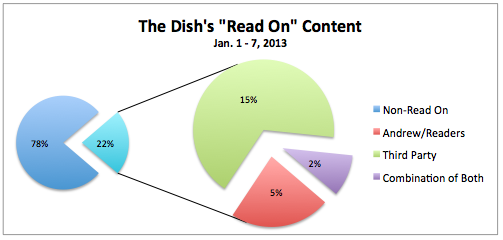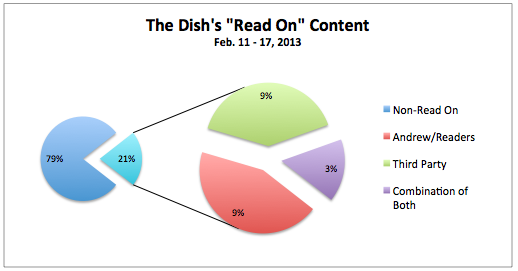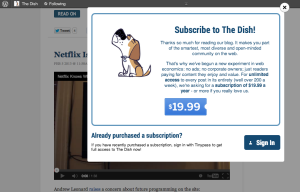I’m not usually a List Guy, and I’m even less a Listicle Guy (nor do I know the difference). But given the recent dearth of writing on this blog dealing with non-Homeland subjects, the end of the year seemed like an appropriate time to select 10 posts from 2013.
Note that these aren’t necessarily my 10 favorite posts, nor were they all posted this year (one wasn’t), nor were they even the ones that garnered the most views (although this category is the general baseline I used to compile the selection below). It is simply a list that expresses, in some abstract or nonsensical way perhaps, The First Casualty in the year that was. Or more accurately, the year that is, until Wednesday.
So without further commentary:
10) “Did you get into Harvard?!?” by Sam Lim (April 6)
Money quote: “While the general perception is that having a degree from an Ivy League school, Stanford, or MIT automatically trumps a degree from most other institutions, the truth is our focus should be on the substance of the degrees and not the degrees themselves.”
9) “At Fernandez v. California Oral Argument, Supreme Court Debates What It Means To Be Roommates” by Victoria Kwan (November 14)
Money quote: “From today’s argument, it looks as though the Supreme Court will reduce Georgia v. Randolph to ‘nothingness,’ as Justice Ginsburg mused. Sotomayor may be able to convince Ginsburg and Kagan, who both showed some discomfort with the amount of control their conservative colleagues would hand to the police. She might also get Breyer’s vote if she can somehow figure out a test that is consistent with both his Randolph concurrence and his desire to limit it in situations like these. Without the support of Scalia, however, the list of justices supporting Fernandez’s claim is stuck at four, which, in the Supreme Court, is still a losing number.”
8) “Beyond the Dish meter, part II” by Jay Pinho (February 18)
Money quote: “I believe Sullivan mentioned recently that if the pace of subscribers didn’t pick up, he may ‘nudge’ them towards paying their dues. This could happen in one of two ways. Either he could reduce the number of monthly “Read On” clicks it takes to trigger the meter (it’s currently at seven), or he could introduce more “Read On” posts as a percentage of his total posts. As an early subscriber, it doesn’t really matter to me which one he chooses. But so far at least, the content lying beyond the “Read On” button certainly seems to justify the annual fee.”
7) “‘Too Far, Too Fast:’ A Timeline of Ruth Bader Ginsburg’s Disappointment with Roe v. Wade” by Victoria Kwan (May 14)
Money quote: “Though Justice Ginsburg’s remarks may be particularly relevant now–her preferred bottom-up, state-by-state approach to abortion mirrors the strategy that same-sex marriage advocates have been using–this isn’t the first time that the justice has publicly expressed disappointment with Roe’s lack of judicial restraint. Over the years, Ginsburg has been quite vocal about the many roads not taken, even while she approves of the outcome of increased access to abortion.”
6) “‘The Choice’ to stay: Sam Lim and I discuss the season finale of Homeland” by Sam Lim and Jay Pinho (December 18, 2012)
Money quote: “So it looks like that’s our two-man consensus: Saul and Carrie’s relationship takes a turn for the weirder. Or at least, it becomes more complex. I like your prediction of a new main character too: I think that will be necessary, especially after killing off Abu Nazir, Walden, and Estes all in the space of three episodes.”
5) “Whose ‘journalistic malfeasance?’ Fact-checking Joshua Foust’s Guardian critique” by Jay Pinho (June 17)
Money quote: “At the end, Foust laments the barrage of misleading and inaccurate news. He is right: the mainstream American press has had a rocky few months. (In reality, it’s been rocky for far longer than that.) Twitter and other real-time social networks have certainly contributed to the proliferation of these deceptions at ever-faster speeds, although they fact-check just as fast. I actually agree with the general thrust of Joshua Foust’s analysis of The Guardian‘s hasty reporting that appears to have cut corners in dangerous ways. But sometimes even the fact-checker needs a fact-checker.”
4) “A broken Constitution, and a few misplaced facts” by Jay Pinho (December 5)
Money quote: “I bring all this up not to rag on Toobin, who is obviously an astute legal mind. I enjoyed his article and am generally sympathetic to the complaints registered by the progressive movement regarding the Constitution’s many inadequacies. But several passages somehow slipped past The New Yorker‘s legendary fact-checking desk.”
3) “2013 March Madness: College Costs-Style” by Sam Lim (March 20)
Money quote: “In all seriousness, though, skyrocketing college costs are no laughing matter. Given that these numbers show how much students must pay (read: borrow) AFTER they’ve exhausted scholarships and grants, there’s already a great need to boost student financial aid and implement more student-friendly policies. If perhaps more schools followed New Mexico State’s lead (estimated annual net price: $2,344), we might actually be able to curb the growing student debt bubble a bit.”
2) “No Saint in this game: Is Wynn Resorts using Everett United to gain casino support?” by Jay Pinho (May 30)
Money quote: “Everett will get its chance to vote for or against the proposed casino in just a few short weeks. If, as expected, the residents approve the proposal and if Massachusetts subsequently awards the gaming license to Wynn and not either of his competitors, time will tell whether the ambitious project is beneficial to Everett in the long run. But it shouldn’t be too much to ask to ensure that Everett’s residents know just who is purporting to unite them.”
1) “My problem with TEDx” by Jay Pinho (February 17)
Money quote: “The ritualistic — at times almost mystical — nature of the event was deliberately designed so as to overwhelm each listener’s critical faculties with all the pomp and circumstance of a staged performance. It was no accident that, following the final lecture, we were all ushered quickly out to the neighboring lounge, where a bar had been set up with wine and beer, and where we were quickly serenaded by a singing theater troupe while we downed our various alcoholic beverages. The point is not to think: it’s to believe.”
Believe it or not, this list actually excludes the two single posts with the most page views this year: Victoria’s March 5th commentary on Jeffrey Toobin’s profile of Justice Ruth Bader Ginsburg (712 page views), and my May 26th “statistical jaunt” through more than 1,100 views from Dish readers’ windows (926 page views).
So yes, five of the 10 posts in this selection were written, at least in part, by Victoria and Sam. Their posts in aggregate represented a disproportionate number of eyeballs on the site, and — far more importantly — an even more disproportionate contribution to the quality of the blog itself.
Looking forward to 2014! Here’s your last song for the year:

















 As most of the world knows by now — and by that I refer mainly to people like the ones that populate my Twitter feed — Andrew Sullivan has cut himself loose. On Monday, February 4th, The Dish officially switched over from the Daily Beast to
As most of the world knows by now — and by that I refer mainly to people like the ones that populate my Twitter feed — Andrew Sullivan has cut himself loose. On Monday, February 4th, The Dish officially switched over from the Daily Beast to 
